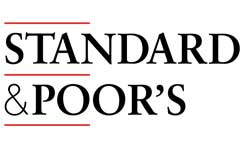Dernières news
S&P : Le risque de crédit dans l'économie tunisienne devient «extrêmement élevé»

{legende_image}
L’agence de notation Standard & Poor’s (S&P), dans une évaluation du secteur bancaire tunisien, publiée jeudi 28 juin 2012, a indiqué qu’elle maintenait le BICRA (Banking Industry Country Risk Assessment) de la Tunisie (BB/Stable/B) dans le groupe '8'. Elle a également décidé d’abaisser le score de risque économique (une composante du BICRA) de 8 à 7. Le score de risque industrie (une seconde composante du BICRA) reste, quant à lui, évalué à '8'.
La baisse de l'évaluation de la "résilience économique" et du "risque de crédit dans l'économie" reflète le point de vue de Standard & Poor’s : les indicateurs économiques, fiscaux et externes, sont plus faibles maintenant que l’avait prédit l’agence et affecteront, de ce fait, le secteur bancaire de la Tunisie. La détérioration de la situation économique va peser, pour sa part, sur les banques en augmentant les coûts de crédit et en réduisant leur capacité génératrice de revenus.
Standard & Poor’s a rappelé, dans ce contexte, qu’elle avait abaissé, le 23 mai dernier, les notes de crédit souverain de la Tunisie à 'BB / B' et lui a attribué une perspective stable.
La baisse du score de risque économique à '8' est basée sur la révision de la de la "résilience économique" de «risque élevé» à «risque très élevé» alors que Standard & Poor’s maintient son évaluation concernant le «risque intermédiaire» du déséquilibre économique. Le risque de crédit dans l'économie passe, quant à lui, d’une évaluation de «risque très élevé» à «risque extrêmement élevé».
Notons qu’une analyse BICRA pour un pays couvre les institutions financières notées et non notées qui reçoivent des dépôts, accordent des crédits, ou sont engagées dans les deux activités à la fois. Un BICRA est noté sur une échelle de 1 à 10, allant du risque le plus bas des systèmes bancaires (groupe '1 ') au risque le plus élevé (groupe '10').
I.N. (D’après communiqué)
Texte original en anglais
On June 28, 2012, Standard & Poor's Ratings Services maintained its Banking Industry Country Risk Assessment (BICRA) on the Republic of Tunisia (BB/Stable/B) at group '8'. It also lowered its economic risk score, a component of the BICRA, to '8' from '7'. The industry risk score, a second BICRA component, remains unchanged at '8'.
RATIONALE
The lowered assessment of "economic resilience" and "credit risk in the economy" reflects our view that economic, fiscal, and external indicators--both in reported data and in our revised forecasts--are now weaker than we previously anticipated and will affect Tunisia's banking sector.
Economic deterioration will weigh on banks by increasing credit costs and lowering revenue generating capacity. On May 23, 2012, we lowered the sovereign credit ratings on the Republic of Tunisia to 'BB/B' and assigned a stable outlook (see "Tunisia Foreign And Local Currency Ratings Lowered To 'BB/B' On Weaker Economic Indicators; Outlook Stable," published on RatingsDirect on the Global Credit Portal).
Our opinion of the higher risk operating environment is incorporated into our reassessment of "economic resilience" to "very high risk" from "high risk" and "credit risk in the economy" to "extremely high risk" from "very high risk," as our criteria define these terms. We have consequently revised our economic risk score on Tunisia to '8' from '7'.
Our criteria define the BICRA framework as one "designed to evaluate and compare global banking systems." A BICRA analysis for a country covers rated and unrated financial institutions that take deposits, extend credit, or both.
A BICRA is scored on a scale from 1 to 10, where group 1 comprises the world's lowest-risk banking systems. Other countries in BICRA group '8' include Egypt, Lebanon, Argentina, Kazakhstan, and Nigeria.
The economic risk score of '8' is based on our lowered assessment of economic resilience to "very high risk" from "high risk," our maintained assessment of economic imbalances as "intermediate risk", and our lowered assessment of credit risk in the economy to "extremely high risk" from "very high risk".
We view Tunisia as having a relatively diversified economy that remained fairly resilient during the economic downturn of 2008-2010. However, despite overall stability and consensus since the removal of President Ben Ali in early 2011, we believe that economic, fiscal, and external indicators have deteriorated, while pronounced medium-term policy uncertainties will persist at least until Tunisia adopts a new constitution and elects a government.
Lower growth prospects in Europe, which is Tunisia's main trade partner and largest source of FDI and tourists, have contributed to the 1.8% contraction in real terms of GDP and external debt accumulation in 2011. We anticipate that the sharp fall in tourism, increased unemployment, and the effect of social unrest on the manufacturing and mining sectors will weaken Tunisian banks' corporate portfolios.
We do not see signs of an asset price bubble in Tunisia. While real estate prices grew by 8% on average during 2006-2010, we believe they have been relatively stable in 2011. The regulation limiting home ownership to nationals further contributes to price stability. There is also no sign of an equity price bubble: inflation-adjusted equity prices have grown by less than 2% over the past two years.
We note, however, that Tunisia's current account deficit and external debt position have deteriorated. Amid a collapse in tourism receipts, the current account deficit has widened sharply to 7.4% of GDP in 2011, while we expect net external debt to GDP to exceed 32% in 2012.
Lending was moderate previously, and we expect credit growth will remain subdued in 2012. At the same time, we anticipate that asset quality will weaken further over the next few quarters because of the less-supportive economic environment, including the weakened tourism sector. Nonperforming loans (NPLs) are high, officially at 13.3% at year-end 2011. We view this figure as somewhat underestimated, partly due to a regulatory forbearance that enabled banks to suspend classification on some new NPLs. The full identification and recognition of NPLs is a work in progress, with the gradual implementation of more sophisticated risk management tools. We also believe that lending and underwriting standards are "relaxed", as our criteria define this term, while payment culture and adherence to the rule of law are "weak".
Our industry risk score of '8' is based on our opinion that Tunisia has a "very high risk" assessment in its "institutional framework" and "systemwide funding" and "high risk" in its "competitive dynamics," as our criteria define these terms.
Our "very high risk" assessment of the institutional framework is underpinned by weak banking regulation and supervision and limited governance and transparency. While the regulatory framework appears conservative in terms of solvency requirements, we believe that the level of problem loans is underestimated and coverage by provisions is insufficient.
Tunisian banks have a high risk appetite, as they seek to compensate for low margins in a fragmented and competitive market. Although the sector has been stable in the past, we expect future reforms to somewhat alter the competitive dynamics, enabling consolidation and potentially letting in new players. The timeframe for these reforms is uncertain, however. Positively, there are no particular market distortions affecting the sector and Tunisians banks do not feature high-risk characteristics related to complex or risky products.
The banking system is primarily funded by a stable customer deposit base. However, core customer deposits alone are insufficient to fund loan portfolios and the average loan-to-deposit ratio is higher than for some regional peers.
Funding support from foreign parents is limited and relates only to a handful of private banks that control a modest market share. These characteristics are further underpinned by a narrow domestic debt capital market.
We consider the Tunisian government as "supportive" of domestic banks. Although we recognize the track record of support, we are of the view that the government has limited financial flexibility and capacity to provide extraordinary financial support to banks in times of stress.
Dans la même Rubrique

Poulina propose 0,45 dinar de dividende par action
09/05/2025
0
Commentaires
Pépites

Zina Jiballah : ils menacent de nous brûler vifs !
09/05/2025
6

Photo du jour : Kaïs Saïed face à ses élèves
09/05/2025

On veut faire disparaitre Kamel Letaïef
09/05/2025
13












